
- Homepage
- Amplifier Type
- Amp (7)
- As Description (11)
- Attenuator (9)
- Cabinet (740)
- Cabinets (15)
- Combo (1045)
- General (12)
- Guitar (37)
- Guitar Amplifier (20)
- Guitar Speaker (13)
- Head (101)
- Not Specified (22)
- Solid State (9)
- Speaker (87)
- Speaker Amplifier (9)
- Speaker Cabinet (8)
- Stack (37)
- Subwoofer (8)
- Tube (24)
- Various (20)
- Other (1779)
- Brand
- Model
- 5e3 (6)
- Ac-15 (25)
- Ac-25 (13)
- Acoustage (7)
- Adio Air Gt (11)
- Bc108 (6)
- Celestion G12t-75 (14)
- Cube Street Ex (7)
- Fly 3 (13)
- G12m (7)
- G12m-65 (7)
- Jazz Chorus (7)
- Katana-air (6)
- Peavey Vypyr X 2 (6)
- Spark Go (7)
- Super Reverb (14)
- Twin Reverb (9)
- Vintage 30 (14)
- Vox Brian May Mv50 (7)
- Yamaha Thr10ii (8)
- Other (3819)
- Product Line
- Blackstar Fly 3 (6)
- Celestion (7)
- Celestion G 12 V 30 (6)
- Celestion G12t-75 (13)
- Crush (6)
- Deluxe (51)
- Guitar Amplifier (6)
- Max (7)
- Pathfinder (11)
- Peavey (9)
- Roland Cube (6)
- Roland Jc (9)
- See Description (11)
- Spark 40 (7)
- Spider (13)
- Thr Series (28)
- Unknown (9)
- Vox (7)
- Vox Amplug 2 (10)
- Vox Nutube (7)
- Other (3784)
- Suitable For
- Venue Type
Peavey invectiveT. 212 120w 2x12 Stereo/Mono Guitar Speaker Cab USA Made NEW
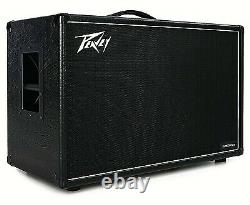
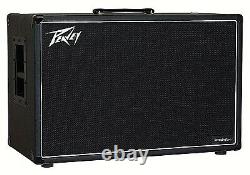
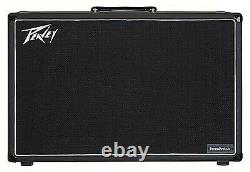
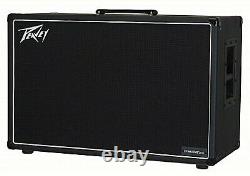
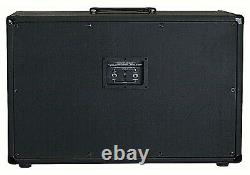
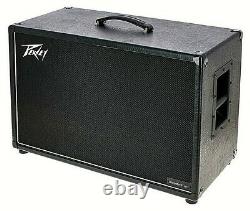
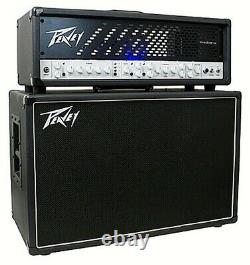
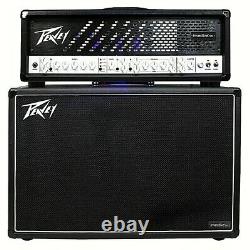
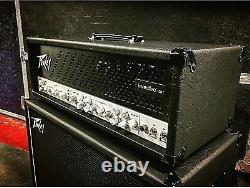
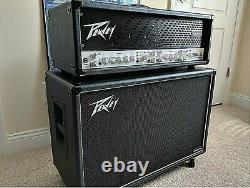
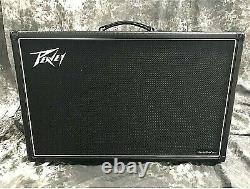
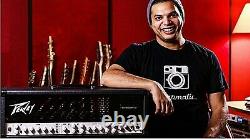


212 Misha Mansoor Signature 120watt RMS 2x12" Closed Back Finger-Jointed Solid Pine 1x16-Ohm Mono / 2x8-Ohm Stereo Switchable Electric Guitar Speaker Cabinet w/- Parallel Inputs and 1 x Celestion® Vintage V30 12" Driver & 1 x Celestion® CreambackT G12H-75 12 Driver. Peavey's BEST EVER Guitar Speaker Cab.
Even better when teamed up with the completely MIDI programmable Peavey® invectiveT. 120 Misha Mansoor Signature 120w All-Valve Electric Guitar Amplifier Head & 10-Button MIDI programmable Footswitch. 212 - 120w 2x12 Speaker Cab. The Misha Mansoor Signature Guitar Cabinet.
When designing his signature invectiveT. 120 electric guitar amplifier head. And Peavey® knew the amp needed a cabinet that would faithfully translate the amp's variety of tonal options. They achieved this goal with the Peavey® invectiveT. 212, 2 x 12 cab. Loaded with one Celestion® Vintage V30 and one Celestion® CreambackT, the cab balances warm vintage tones with the cutting mids of the Vintage 30. 212 boasts parallel inputs for sending each speaker its own signal.Peavey partnered with Celestion® speakers to voice their invectiveT. 212 120-watt 2 x 12 cabinet. They chose to pair a midrange-heavy 60-watt Vintage V30 with the warmer tones of a 60-watt CreambackT. When played together, this pairing balances the cut you need for punching through the band with the rounder tones of the CreambackT.
This is especially beneficial when separately miking each speaker. You're able to blend the signals of both to taste. There are two ways to run the invectiveT.
You can plug a single input to achieve the full 120 watts at 16-Ohms. Step back and you'll hear the full glory of the Vintage V30 and CreambackT working together. 212 120-watt cabinet features parallel inputs. You're able to run separate signals into each speaker - great for stereo setups as well as wet-dry rigs. In this rig, you'll gain 60 watts from each speaker at 8-Ohms.PUSH BIG - BEEFY INVECTIVET SOUND TO THE MASSES. WITH THIS MATCHING CELESTION®-LOADED CAB. 212 cabinet is perfectly suited for use with the invectiveT. The solid pine construction provides the most responsive dynamics imaginable and complements the metal-standard Celestion® Vintage V30 (8-Ohms) speaker paired with the CreambackT G12H-75 (8-Ohms) speaker.
It's a sonic quality so worthy that many guitarists who have already tried the invectiveT. 212 describe it as the best cabinet I've ever heard. Plug right in using the ¼inch. In Stereo, players will get a left/right configuration rated at 8-Ohms per side at over 60w (RMS) per side. In Mono mode, the invectiveT. The cabinet's finger-jointed construction and premium components throughout ensure extreme road worthiness and reliability, enabling the player to blast off with confidence. Misha Mansoor Signature 2x12 speaker cabinet.Perfect match for Peavey's invectiveT. 120 electric guitar amp head.
Pairs a Celestion® Vintage V30 and a Celestion® CreambackT for modern and vintage tonalities. Parallel input allows you to run a mono or 2 separate signals. Handles 120 watts at 16-Ohms. Signature rig is complete with the Peavey® invectiveT. Made to be paired with the Peavey® invectiveT.
412 120w Head, this cabinet packs humongous sound, thanks to 4 premium 12 Celestion® drivers, and an indestructible build. This cab is for the heavy player who wants to get the most excellent sound and incredible volume from a cabinet. Made in the USA, this cab was created to perpetuate the heaviest of modern metal sounds. It handles the sparkling cleans of an intro, or the intense gains of a break down.
Trusts with his unrivalled heaviness, putting out tons of raw power and maintain the best possible sound around. 4 x PREMIUM 12 CELESTION® DRIVERS. Celestion® speakers are revered in many circles. You'll find some of the top cabs and combos sport Celestion®s. 412 Cab is stocked to the brim with four 12 Celestion®s - two Vintage V30's paired in an X pattern with two of the new CreambackT G12H-75.The combination creates a sound that is truly remarkable. With a build as strong as its sound, the invectiveT. 412 Cabinet can take a few hits. It's made from solid ¾" (1" stock) finger jointed pine construction and has removable EDL® Casters. It's crafted from the best material construction so you can take it on the road, leave it in the garage, or do whatever else you need to do without thinking twice.
It weighs 94.36lbs and has dimensions of 31.5" W x 17.75" D x 34.75 H. Now that's a solid piece of equipment.
(5 out of 5 Stars). BEST 2x12 Cab I've Ever Played Through. Now I Have To Get The 4x12!212 is without a doubt the best 2x12 cab I have ever played through. Great job Peavey, you guys certainly nailed it again with the invectiveT. 120 and the invectiveT 2x12 and 4x12 cabs. Hopefully I will be able to connect with Dave here at NTM and find one available when the holiday season roles around. I had been wanting this amp and cab since I heard it was going to be released several years ago, and ever since I finally got mine earlier this year I have played it every single day and it still never ceases to amaze me.
I can't say enough about my Invective cab, it's such a killer cab, and while any quality cab sounds good with the invectiveT. 120 Head and the invectiveT. 212 Cab certainly sounds noticeably better when they are paired up together as they are meant to be.
It's not just the Vintage V30 & CreambackT speaker combination that is responsible for making the cab sound as great as it does though, because I have since tried the two speakers in two other cabs and something about the cab itself (not sure if it's the sizing, the materials, the quality construction, or all three combined) is special because it sounds just plain better. It's impossible to get a bad tone from these cabs.GtrPlyr83 from RICHMOND, VA - October 7, 2021 Music Background: 28 years a guitarist and counting. Customize, maintain, and repair gear as well. Recently started to learn about recording/tracking and having fun with that too. Looked at Bogner® with this same speaker config but the price was out of my budget. Also was not impressed with the matching "MASSHALL" cab that matched my Marshall® head so my rep Scott Augustyniak told me about this Peavey® invectiveT.
212 cab loaded with a Celestion® Vintage V30 and a Celestion® CreambackT which I was looking for in a 212 cab. I had my doubts (not a big Peavey fan) but went ahead and ordered it. Construction is solid and the sound is awesome with clear notes and great bass response. Paired it with my new Marshall® SV-20H head and the two are a great match for me. I use it in my small studio and is perfect for my needs. The speaker combo is a great mix for great sound. Who needs a 412 when this 212 is so awesome? More than I had expected, looking for a great 212 cab this might be a great choice, it was for me. Thanks Scott for all your help. From Chino Valley AZ - June 4, 2021.Beautiful, solid, well made cabinet. The blend of the CreambackT and the Vintage V30 is excellent, great bottom end and very punchy. NTM Customer from February 23, 2019. Fat and warm with a lot of bottom end. Very tight and solid construction.
Warm, tight, woody tones with a great bottom end. Very good paring with 5150®-ish amps. Sounds fabulous mic'd up and in the mix. I'm running a Peavey® 3120T through it and I'm back in love with that amp because of this cab. Also sounds great with my PRS® MT15, though I have to push the mids and treble up a bit because it's a darker voiced amp.
The BEST from Yeah December 30, 2018 Music Background: Dominating the scene. Got this with my Peavey® invectiveT. 120 and WOW what a combo. Clean look with such an awesome sound. Thanks Drew my sales guy for getting this to me asap. Jeret from Corona, CA - June 17, 2018 Music Background: Guitar Player. Simply amazing tone paired with my Peavey® 6505MHT 20w lunchbox amp, ESP® HorizonT with EMG® 57/66. Very solidly built- very cool looking too when its flipped vertically on its side (badge flipped 90 and feet snubbers switched to make it look factory) with the amp on top. Nick from Stockton, CA - January 12, 2018 Music Background: Experienced musician Rated: 5/5.PEAVEY® - We Are Innovation. Driven by an unmatched legacy of innovation and a total dedication to quality and reliability, Peavey Electronics embodies the pursuit of perfection in music and audio. It's our unifying spirit. It's proven - and it continues today.
For nearly five decades, Peavey has blazed its own path toward musical perfection. Founded by Hartley Peavey in 1965 as a one-man shop, today Peavey Electronics Corporation is one of the largest makers and suppliers of musical instruments, amplifiers and professional audio systems in the world-distributing more than 2,000 products to more than 130 countries.
Hartley has famously said, In order to be better, by definition you must be different. His quest has led to more than 180 patents and innovations in the way we hear and play music.Hartley Peavey is not only the visionary, lead engineer and chief executive, but also the lynch pin that connects a rich history to a bright future. PEAVEY ELECTRONICS - CORPORATION HISTORY. Since its founding in 1965, our company goal has always been to build the best products available while at the same time making them affordable through the use of the most modern computer-assisted design manufacturing methods available. Exports to more than a hundred countries accounted for an estimated 40 percent of sales. The company also has manufacturing operations in Foley, Alabama, and in Corby, England, and distribution centres in The Netherlands and Canada.
Its chief competitor is Yamaha, the Japanese conglomerate. Founder Hartley Peavey, whose "hometown boy makes good" story made him a local legend in Mississippi, has been the recipient of numerous awards for entrepreneurship, including the "E Star" award for success in international markets from the U.He was also inducted into Hollywood's "Rock Walk of Fame" in 1990 for his contributions to rock'n' roll music. Musical Ambitions in the 1950s.
Hartley Peavey grew up in Meridian, Mississippi, and had early aspirations of becoming a rock'n' roll guitar player. As a teenager in the late 1950s, he worked in the Peavey Melody Music Store, owned by his father, J. "Mutt" Peavey, and tinkered with building amplifiers for local musicians. When, as he once confessed to. Magazine, he turned out to be a "pretty lousy guitarist, " Peavey decided his future was in making amplifiers.As he later recalled in "Music and Sound's Greatest Hit, " published by Peavey Electronics for its 25th anniversary: I would build one (amplifier) a week, go out and sell it, come back and start on another one. The amplifiers were inscribed with the lightning bolt logo that Peavey had designed as a college freshman.
A year later, Peavey moved the business from the family's basement to an attic in the building that had housed his father's music store. Peavey also hired his first employee, a salesman, so he could concentrate on building amplifiers. In the mid-1960s, however, there were many larger, better-known companies making amplifiers, and Peavey soon expanded into building public address systems to keep his young business afloat. In the company's 25th anniversary retrospective, Peavey explained that as I travelled and talked to music dealers, I realised there was no shortage of instrument amplifiers.
But if you wanted a PA system there were essentially only two available and both were expensive systems.... Most folks think I got into the music business with guitar amps. Over the next five years, Peavey Electronics enlarged the building seven times, and having grown to more than 150 employees, in 1973 the company began construction on Plant #3, which would become its main manufacturing facility. To hire enough skilled employees, Peavey Electronics established training courses at Meridian Community College.
Over the years, Peavey was often asked about his decision to keep the company in Meridian. That Mississippi unfortunately runs dead last in everything. Back in 1965, when I got into this, I was too damn dumb to know it couldn't be done. " He went on to say that he had "lost count of how often he wished he had built Peavey Electronics somewhere else.In a later interview with his hometown newspaper. Peavey explained, What I tried to say in the. Article was that Mississippi presented many difficulties in starting a high-tech business.
And some of these difficulties exist to this day. In 1982, the City of Meridian honoured its hometown industrialist by proclaiming April 21 as Hartley Peavey Day. In the late 1980s, when the company was considering building its first U. Manufacturing facility outside of Mississippi, then-Governor Ray Mabus worked with Peavey Electronics and Meridian Community College to create The Meridian Partnership, the first private-sector use of the Job Skills Education Program, a technology and basic-skills program originally developed by the U. In the early 1990s, Peavey Electronics opened a 58,000-square-foot training centre, complete with its own recording studio, for its employees and more than 1,200 dealers. In Boca Raton, Florida, where he and his wife had a second home, People ask me why Mississippi and I say, Where do you think rock'n' roll was born? Vertical Integration in the 1970s. It was in the early 1970s that the company began the vertical integration that would make it unique among major electronic musical equipment manufacturers.Eventually, Peavey Electronics would build everything it needed for its musical instruments, from cabinets and metal work down to making its own circuit boards and running its own advertising agency. In 1990, Peavey explained, If somebody local had been able to subcontract for me the things I needed to build amplifiers, I would probably still be using subcontractors. We had to learn to make our own chassis, our own circuit boards, and eventually everything'in-house.
And while we thought it was a tremendous disadvantage, and in many ways, it was, we discovered that it was the best thing that could have happened. In the mid-1970s, Peavey Electronics also began manufacturing electric guitars, again more from necessity than design. These companies, with their immense marketing power, began encouraging dealers to sell their guitars and amplifiers as a package deal, cutting into sales of Peavey amps.
Years later, Peavey recalled, When we announced that we were making guitar bodies on computer-controlled machinery, some of the most prominent names in the industry said,'Impossible. Everybody knows you can't make guitars with a computer. That was a rather simplistic attitude, we thought, because, in fact, we weren't making guitars on computers. Computer-controlled machines to make precision guitar parts to tolerances that heretofore manufacturers couldn't even think about approaching.Guitar makers are always talking about hand craftsmanship. What hand craftsmanship is, in many instances, is the ability to fit together parts that are produced with a lot of'slop' in them. In the early 1990s, Peavey Electronics would establish a Computer-Integrated Manufacturing (CIM) system to link and track all aspects of its manufacturing, and increasingly the company was using robotics in its assembly processes.
The company, however, had an unofficial no-layoffs policy and employees whose jobs were eliminated by technology were retrained for other positions. In 1994, Jere Hess, then director of public relations, told. No one in this company has ever lost their job because of automation. When Peavey Electronics celebrated its 25th anniversary in 1990. Published a 40-page special edition to honour the company that had become the area's largest employer.
The newspaper noted that Peavey Electronics created more than 1,000 new jobs in east-central Mississippi between 1980 and 1989, including more than 850 in the Meridian area, and 73 percent of all new manufacturing jobs in Lauderdale County. Among those saluting the company was Mayor Jimmy Kemp, who said, Of course the obvious things you think about when somebody in your community employs 1,850 people is the enormous impact it has on your city, which is fantastic. I'd hate to think what we'd do without Peavey Electronics as far as our city is concerned. Peavey Electronics was then the tenth largest manufacturing employer in the state. In 1991, Peavey Electronics was one of 20 companies selected by the U.Department of Commerce to participate in a five-year program designed to stimulate export of U. As part of the program, the Department of Commerce arranged meetings between heads of the U.
Companies and Japanese officials, including Prime Minister Toshiki Kaifu and Minister of International Trade and Industry Eiichi Nakao. Peavey Electronics, which first entered the Japanese market in the mid-1970s in a short-lived relationship with industrial giant Yamaha Corporation, also agreed to participate in at least one trade show a year in Japan.Although the company contracted with other distributor, Japan was never a significant market. In 1991, President George Bush chose Peavey Electronics as the site to give a speech on economic growth.
Noted, Hoping to pump fresh air into his sagging popularity, President Bush hailed the success of Meridian's Peavey Electronics Co. As proof that Americans can excel in a worldwide economic battle.
A Brief History of Peavey Amplifiers. A Legacy of Quality & Affordability.The story of how Peavey became one of the largest audio manufacturers in the world is one of humble beginnings and a well-deserved reputation for quality, value and innovation. Growing up as a guitar or bass player, you've probably owned or played your fair share of Peavey amps, since the company's catalogue is so affordable, diverse and well distributed. After graduating from Mississippi State in 1965, Hartley Peavey started his company above his father's music store, building amps one at a time.
Not only is the company passionate about sound, it is equally passionate about build quality and affordability. Peaveys are known for their innovative circuitry, being built like tanks and for being affordable enough for musicians at every level, across the globe. In 1961 Hartley Peavey made his first amplifier and adorned it with the instantly recognisable company logo, which he designed himself in high school.
When he launched the company four years later, Peavey produced only two amplifiers: The Musician and Dyna Bass. Both models were high-wattage, solid-state amplifiers that included simple features for the working musician. In 1973, Peavey began development on a series of vintage Fender Twin inspired amps, with 6L6 power tubes and two 6C10 pre-amp tubes. These amps had a different sonic signature than the Twin and had their own unique sound.Since solid state was all the rage back in the 1970s, later versions capitalized on new technology, which enabled the combination of solid-state pre-amps with tube power amps. The vintage series was the precursor to the now popular all-tube Classic Series®, which features an EL84 power section that effectively combines classic Vox- and Fender-type tones in one convenient and versatile amp for use in many different styles of music. With solid state amps becoming increasingly popular in the'70s and early'80s, Peavey developed what is arguably its most famous solid-state amp: The Bandit®. Conceived in 1980, the Bandit since has gone through many revisions and Bandit®s still are being produced today with Peavey's own TransTube® technology. This innovative feature emulates the sound and feel of a tube amp using solid state power.
Peavey accomplished this by modelling the overload characteristics of the amp and transformer as well as emulating the sound of asymmetrically clipping tubes. Early model Bandits are instantly recognisable by their multi-coloured knobs and silver panels adorning the sides of the grill cloth. Varying in wattage over time, the Bandit has become a reliable tool in the solid-state amp lover's arsenal. More Gain for'80s Metal Players. When hair metal first hit in the'80s, players required more gain for new playing techniques, such as two-handed tapping and sweep picking.
Marshall was ahead of the curve for this particular sound with the coveted JCM800 2203, but Peavey offered its take on that circuit with the Butcher and VTM series. Instead of Marshall's usual EL34 tubes, both series of Peavey amps used 6L6 power tubes, which yielded a darker sound and a less apparent upper-mid presence.
Many compare the VTM to a hot-rodded JCM800 and the Butcher to a normal JCM800, but even though these amps may share similar tonal characteristics, they are definitely their own beasts. These amps are extremely versatile and can be bought for much less than comparable competitors.
In the early'90s, more players began demanding even more gain, power and options, and Peavey moved to the front of the pack, via the three-channel Ultra Plus®, a currently undervalued amp. The Ultra Plus® could cover any genre of music with its crisp-and-spanky clean channel for country; crunch channel for rock's cutting mid-range; and ultra-channel for searing leads and metal riffs.
Using an active EQ section, the user could boost or cut any frequency with precision and dial in his own desired tone. Peavey seems to favour 6L6 power tubes, and at 120 watts this head could do the job for any situation. It was a precursor to the Triple XXX® series, which was a slightly modified version of the Ultra Plus, but it featured updated aesthetics, including a metal face plate akin to a Mesa Triple Rectifier.Peavey since has come out with the Triple XXX®II, which features switchable power tubes from the stock EL34s to 6L6s. The Most Famous of Them All. The 5150® was unleashed in 1992 after a two-year collaboration between the creative minds of amp designer James Brown and guitarist Eddie Van Halen.
Featuring two channels, a 120-watt all-tube 6L6 power section and a shared EQ, the 5150® was able to produce a variety of rock and metal tones. The rhythm channel could be set clean or crunchy, but the lead channel is what this amp is famous for. With its super high-gain sound, it could be used for anything from tight and aggressive metal riffs to blistering lead tones. This led to the 5150®II with separate EQs for each channel, which made the amp even more versatile.
In 2004, EVH parted ways with Peavey and the amp was re-branded as the 6505® and 6505®+ (also known as the 6505®Plus), along with the 6534T and 6534T+ (also known as the 6534TPlus), which feature an EL34 power section for a more British flavour. Since its creation, Peavey strives to make powerful, affordable amplifiers so that every musician can have the means to own one and the privilege to play through one. We are the NSW Mid-North Coast Franchise Dealer for these (and more) quality musical instruments and equipment plus loads more guitar, drums, keyboard, recording, and live equipment brands.
For more than 25yrs N E W T O N E M U S I C we provide? LAYBY without time limits & receipts showing remaining balance. BANK DEPOSIT to: Groundwater's Guitar School Inc 58 Commerce Street, Taree NSW 2430?(BSB: 0 6 2 6 0 3 / ACC: 1 0 1 7 1 0 9 2)? STOCK SUPPLY NOTES A note on our rare, classic, vintage, collectable, and used musical instrument amplifier & musical instrument equipment items. Even though we meticulously service, test, clean, polish and warrant all our gear, there may occasionally be some residual scuffs underneath or on the sides, or perhaps a tiny tolex rip on the rear. So, while our gear will be in EXCELLENT CONDITION (for the age), we will always advise you if the gear is in MINT CONDITION or if we feel that the item is perhaps of only AVERAGE CONDITION. Footswitches, Cables, etc available if originally supplied to us by the donor.
This item is in the category "Musical Instruments\Guitars & Basses\Guitar Amplifiers". The seller is "newtonemusic" and is located in this country: AU. This item can be shipped worldwide.
- Number of Speakers: 2
- Model: PEAVEY® invective™.212
- Impedance: 8-16 Ohm Switchable
- Product Line: Peavey® invective™ Series
- Venue Type: Studio, Small, Medium, Large, Stadium
- Amplifier Technology: Guitar Valve Amplifier Speaker
- MPN: 03616670
- Power: 120w
- Amplifier Type: Electric Guitar Speaker Box
- Brand: PEAVEY®
- Suitable For: Electric Guitar
- Country of Manufacture: China Assembly using USA Components

